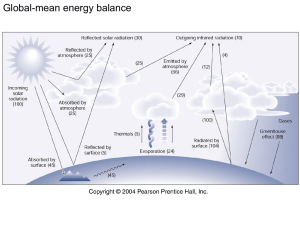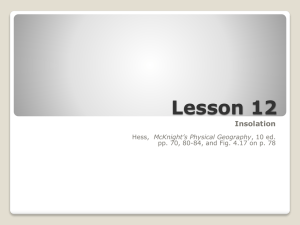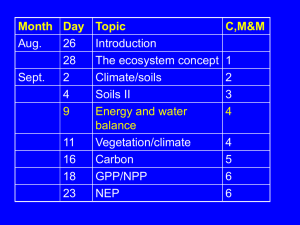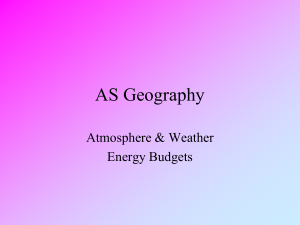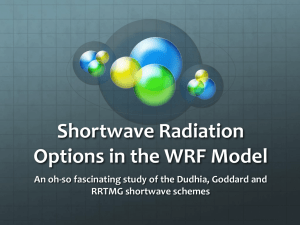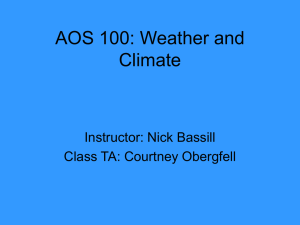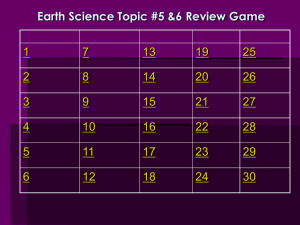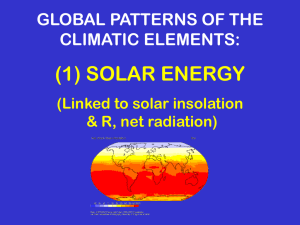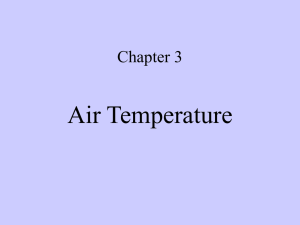Oestreicher Slides
advertisement
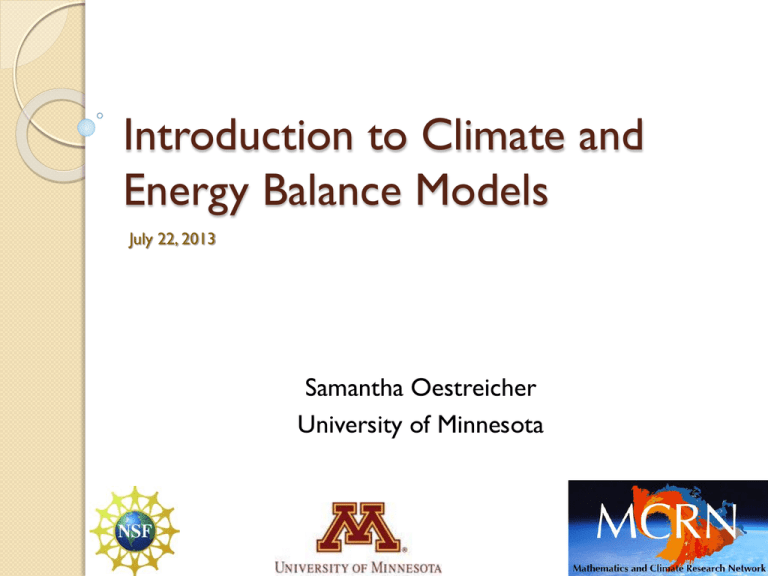
Introduction to Climate and Energy Balance Models July 22, 2013 Samantha Oestreicher University of Minnesota “Some say the world will end in fire…” Outline What is Climate? How do we observe climate? An Overview of Earth’s Climate System. Types of Radiation Energy Balance Model ◦ Stefan-Boltzmann ◦ Budyko-Sellers What is Climate? Climate := 30 year average of weather. What is Climate? Climate := 30 year average of weather. Weather: Do I need an umbrella today? What is Climate? Climate := 30 year average of weather. Weather: Do I need an umbrella today? Climate: Do I need to own an umbrella? How do we observe climate? People have been making observations for hundreds of years. How do we observe climate? How do we observe climate? http://spaceplace.nasa.gov/earth-card-game/terra-lrg.en.png How do we observe climate? http://www.dartmouth.edu/~mpayres/People/Sharon.7506.web.jpg http://www.whoi.edu/ooi_cgsn/auvs-gliders?tid=1621&cid=137956&article=95673 How do we observe climate? How do we observe climate? nicl-smo.unh.edu How do we observe climate? nicl-smo.unh.edu An Overview of Earth’s Climate System 9:35 How do we model climate? http://www.prism.washington.edu/story/Earth+System+Models How do we model climate? There are two main view on how to model climate: 1. “No detail is too small!” Leads to all-inclusive Global Climate Models www.pmel.noaa.gov/foci/ice06/FOCI_Ice2006_phytoplankton.html 2. “The rest is details” Leads to simple Conceptual Climate Models www.nasa.gov/vision/earth/lookingatearth/ice_clouds.html Global Climate Models Complicated choices starting from how to grid the globe. Global Climate Models Global Climate Models Global Climate Models require: Physical sciences • Physical, chemical, biological processes Computer science • Data mining, coupling non-similar grids, error analysis, parallel processing, time optimization Statistics • Extreme events, trends, and averaging Mathematics • Data assimilation, numerical znalysis, PDEs Global Climate Models - Simulation Global Climate Models - Prediction IPCC Report AR4 9:50 How do we model climate? There are two main view on how to model climate: 1. “No detail is too small!” Leads to all-inclusive Global Climate Models www.pmel.noaa.gov/foci/ice06/FOCI_Ice2006_phytoplankton.html 2. “The rest is details” Leads to simple Conceptual Climate Models www.nasa.gov/vision/earth/lookingatearth/ice_clouds.html Energy Balance Models Temperature Change = Energy In – Energy Out Energy Out using Stefan-Boltzmann Law: Temperature of the Sun = 5,778 K Power flux (W/m2) = (5.67 x10-8 )*(5778)4 = 6.33x107 W/m2 Question: What kind of energy is the Sun radiating? Types of Radiation http://www2.webster.edu/~barrettb/courses/mediaproduction.htm Types of Radiation Plank’s Function gives a distribution of wavelengths based on the temperature of the body. Wein’s Law tells us the maximum frequency is inversely proportional to the temperature. ie: Hotter bodies produce shorter wavelengths. The Sun gives off shortwave radiation or ultraviolet. The Earth gives off longwave radiation or infared. Types of Radiation The Sun gives off shortwave radiation or ultraviolet. The Earth gives off longwave radiation or infared. http://www2.webster.edu/~barrettb/courses/mediaproduction.htm Energy Balance Models In the “Global Energy Balance Models and the Goldilocks Zone” section of the MATLAB guide, you will use the Stefan-Boltzmann Law to derive the average incoming solar radiation (or insolation) to Earth. Earth’s Insolation = 342 W/m2 = Q Thus the simplest energy balance model is: Temperature change = energy in – energy out R dT Q T 4 dt Which has equilibrium solution: or Q = sTeq4 (342/s)1/4=Teq Thus Earth’s temperature is modeled to be Teq = 279K = 6 °C = 43 °F Energy Balance Models Teq = 279K = 6 °C = 43 °F But the observed temperature of Earth is only T = 14 °C Stefan-Boltzmann is black body radiation. We need to include albedo. Globally 30% of insolation is reflected back into space. http://www.cocorahs-albedo.org/ Energy Balance Models Energy Balance Models Thus the improved energy balance model is: R dT Q (1 ) T 4 dt Which has equilibrium solution: Q (1- a) = sTeq4 or (342*(1-0.3)/s)1/4=Teq Thus Earth’s temperature is modeled to be Teq = 255K = -18 °C = 0 °F Question: Why isn’t the Earth a snowball? Energy Balance Models Budyko - Sellers Suggest new outgoing longwave radiation (OLR) formulation: OLR = A + BT A and B are determined from satellite observations. T is surface temperature (in Celsius). A = 202 W/m B =1.90 W/m K Dynamics photosphere temperature global mean surface temperature R dT Q (1 ) T 4 dt R dT Q (1 ) ( A BT ) dt Question: What is happening in the atmosphere to cause this discrepancy? Energy Balance Models Budyko-Sellers Energy Balance Model is: R dT Q (1 ) ( A BT ) dt With equilibrium solution T eq Q (1 ) A B This equilibrium solution is stable with eigenvalue –B. (Recall B>0.) Question: What if Earth’s albedo was not 30%? ice 0 . 62 ocean 0 . 32 Budyko 1969 Last Question: Extras

